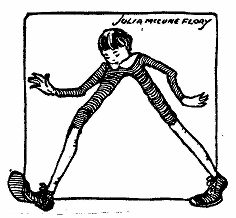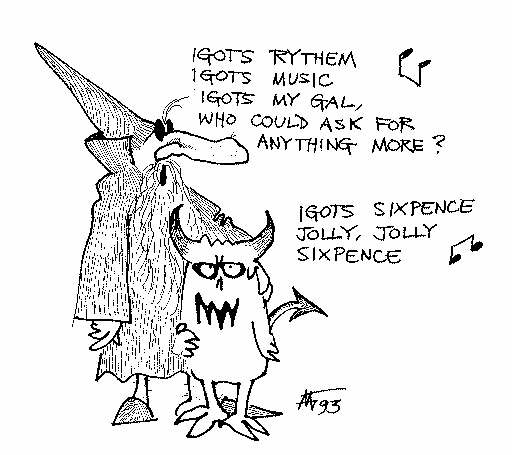
It Goes On The Shelf
Published at The Sign of the Purple Mouth by Ned Brooks
713 Paul Street, Newport News, Virginia - 23605
Web Hosting Domain | Free Website | WebSite Hosting | |

Cover art by Alexis Gilliland
Interior art by Julia McCune Flory from Prologue by Charles S. Brooks
(Harcourt Brace, 1931)
It's February 13 as I start typing this issue - I turned 56 last week. We have had a real winter this year as compared to the previous four years - snow at Halloween, most of a week below freezing in January, and last week a strange ice storm that messed up the roads and caused a lot of power outages inland. Here on Chesapeake Bay it wasn't that bad, though I don't think I've ever seen the gutters packed solid with ice before in the 28 years I've lived in this house. Hope they don't break off!

Rick Norwood writes in reply to my complaint that his Prince Valiant book (of Sunday comic strip reprints) hardly deserves to be called `An American Epic', as it takes place mostly in medieval Europe - Rick points out that the author, Hal Foster, is American (Canadian American), and that one of the subplots involves Prince Valiant discovering America. On that basis we would have to call a similar book of Superman reprints `A Brooklyn Epic'...
George Flynn notes that Prince Valiant also got to China and central Africa... George also says that the `gall' in gallowglass means foreigner, from which he takes it that these bodyguards of Celtic chieftains were mostly foreign mercenaries. But Roger Sheppard (see below under International Directory of Book Collectors) says that galloglass means `young soldier' according to his Standard Oxford Dictionary - aha, but the EOD says it comes from the Gaelic gall `foreigner' + oglach, which can mean `youth', or `servant', or `warrior'. George (and several others) see no objection to the word attendee that Bill Danner dislikes, noting that it parallels refugee and that -ee isn't always passive any more than -e'(e) in French is.
Howard DeVore liked IGOTS so well that he invited me to join The Cult, a legendary fannish apa; and even remembered that I used to be in the NFFF and did I want to take over their Oral History project? I'm honored, but with two apas and a genzine I have no spare time left. Howard also inclosed his PEAPSzine (Pulp Era Amateur Press Association) which has an intriguing quote from The Grim Reaper's Book of Days to the effect that the actor George Zucco died of terror on May 28, 1960, in an asylum in South San Gabriel, California. He believed that Cthulhu was after him - and even more mysteriously, his wife and daughter killed themselves the next night!
Curt Phillips writes that he met two of the Bulgarian fans who had worked on the Orphia mentioned in #11 and that they told him that the project destroyed the sf club in Sofia and bankrupted most of the staff.
Curt also says that he once met Vern Coriell after he moved to Wytheville Virginia - I knew Coriell moved to Virginia before he died, but I never had an address. Curt notes that he had a Bok original on his table at a small con, and wonders what happened to it.
Curt guesses that the foot-treadle on the 1873 Sholes & Glidden typewriter pictures in #11 activates the shift - no, that model was all upper case and had no shift. The foot treadle was the carriage return, and lifted the weight that drove the carriage escapement. Beeching notes (in his Century of the Typewriter) that early users were at risk of having this weight fall on their toes when the cord broke!
Dainis Bisenieks sends a beautiful little booklet called:
Groundhog Day Carols by John and Jan Haigis, Philadelphia (7101 Grays
Ave), 1994, 12 pp, illustrated.
No price is given. The authors seem to be
involved with something called `The Marvelous Megalethoscope'. The ten carols
are set to traditional Christmas tunes.
Dainis notes that I again made a mistake in transcribing the letter from Walt Willis, putting `Anglicism' for Anglicanism - maybe that's why the house caught fire... He also complains that the word geas, which all trufans are familiar with as it is explained in the DeCamp & Pratt's last Harold Shea story The Green Magician, does not appear in the OED. He says he first saw it in Cabell's Figures of Earth. I remember it from DeCamp, and still remember what it means, too. In a later letter Dainis says that geas is defined under the spelling geis - and I see they only trace it back to 1880, though it must be much older.
George Scithers complains that I don't indent paragraphs - but I do. I see that there is an odd glitch in this old typesetter that it doesn't indent right column paragraphs as deeply as it does left column paragraphs. I actually use two levels of paragraphing, the first marked by a skipped line and the second by an indent.
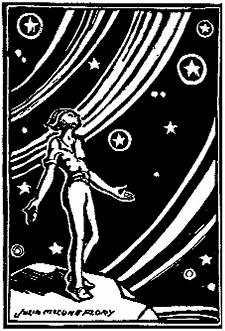
George also notes that my description of the self-erecting tent on p.8 of #11 sounds vaguely obscene - and we all know that vagueness is to be avoided - and wonders how easy the tent is to repack.
Mark Rich was surpised to see his Noriega poem booklet mentioned. He says that the `Conservatory of American Letters' mentioned lastish as the sellers of the Papson ...In A World Not Of His Own Making seems to be a sort of vanity press operation.
Bill Bridget sends an elaborate loc which is an illuminated zine in itself. He also inclosed a floppy disk with an OCR software called Percieve which does much better on old typescript than my CatchWord, though not as well on typeset text images.

Bill also quotes from the February 1993 issue of Discovery on the computer situation in Bulgaria (the Orphia mentioned last time must have been set by computer) to the effect that all of the computers there were either smuggled in or built from pirated designs, and all of the software pirated as well. This article also claims that Bulgaria was the source of many computer viruses in 1990 - but why would the Bulgarians poison the well from which they were stealing software?
Ruth Berman says she had not been able to get the Owlswick Dr Ezsterhazy book and will try Scithers directly. She also says that the artists Charles J. Coll and Joseph Clement Coll were related; and that Charles did art for The Wizard of Way-Up by Ruth Plumly Thompson (which also has art by Marge, of Little Lulu fame), still available for $15 (hc) or $7.50 (pb) from the International Wizard of Oz Club (Fred M. Meyer, 220 North 11th Street, Escanaba MI 49829).
Alexis Gilliland writes that Wallace Smith changed his style after Fantazius Mallare because he went to jail for that artwork - this may or may not be true. The story that Smith went to jail probably spread through fandom from the cover page to the Ronald Clyne artfolio of the art from this book; however the latest Hecht biographer, Bill MacAdams, says that while Hecht and Smith did both plead guilty to the federal obscenity charge, the sentence was $1000 fine each and there is no evidence either spent any time in prison. They had gone to a great deal of trouble to be charged with the crime in order to force a show trial (Clarence Darrow was to have been their lawyer) on the issue of federal obscenity laws, but the scheme fell apart when, of all the prospective expert witnesses for the defense, only H. L. Mencken agreed to appear.
Alexis also mentions that his son Charles was diagnosed as having scarlatina at the 1979 worldcon, so the term (a synonym for scarlet fever) was not obsolete as I thought when I put it in quotes in the review of The Winged Ship in #11.
Peace Advocate, the newsletter of the local Peninsula Peace Education Center, quotes from Article I, Section 9 of the Constitution: `...(a) regular statement and account of the receipts and expenditures of all public money shall be published from time to time'; and notes that this provision seems to have been neglected in using our tax dollars for the `black budget', which ran about $100 million per day during the Bush-Reagan administrations and has hardly been reduced under Clinton - it's still $80-90 million per day. Sheryl Birkhead says the illo on p.4 of #11 looks like Bok's work to her, and asks if the Damon Knight mentioned is the Damon Knight - yes, and I would ask him about it if I had his address.
Sheryl also wants a video of the ConFrancisco Hugo ceremonies, if such a thing is available - which reminds me that although I was an `Attending Member' (though I did not attend) I have never recieved any sort of membership package from the San Francisco gang - has anyone? Aha - this membership packet did appear in March.
Ernest Mann at The Little Free Press notes that the cost and ineffectiveness of the prison system might be due to the profit motive - prisons are more profitable than rehabilitation. I suppose it all depends on what you consider a useful product of the criminal justice industry - the average taxpayer would no doubt prefer a rehabilitated citizen, but to those in the industry the constant recycling of criminals is more profitable! In some states the profit has even been maximized in a way - no one can be sent to prison unless someone else is released. That is, the prison industry is operating at maximum efficiency!
Dave Hall mentions something that I should have noticed, as I have the same book (the Heneage/Ford book on Sidney Sime) - the Christmas 1922 issue of The Graphic has watercolors by Sime to illustrate Lord Dunsany's Travel Tales of Mr. Joseph Jorkens. Has anyone ever seen this magazine?
All There Is To Know ed. by Alexander Coleman and Charles Simmons,
Simon & Schuster, New York, 1994, 405pp, index.
I have the bc edition, which doesn't give the retail price. This is a collection
of excerpts from the 11th edition of the Encyclopedia Britannica of 1911,
and the title refers to the notion common at the time that just about everything
useful had been discovered.
Alas, much of what was `known' in 1911 was wrong; on the other hand, much that was right has been forgotten. Under negro the 11th Britannica baldly stated that they are an inferior race. There are entries for vampires and werewolves, but none for geas... The entry for Alexander Cruden, who compiled the famous concordance to the Bible is fascinating - the labor of doing this without benefit of computer apparently drove him mad.
A fascinating tome to browse in!
Witchcraze by Anne Llewellyn Barstow, Pandora/HarperCollins, London,
1994, 181pp, notes, bibliography, and index, period illustrations.
This is a very scholarly feminist analysis of the European persecutions of so-called
witches. Barstow has a much lower estimate of the number of victims put to death
than I have read other places - some 300,000 over a period of 300 years - but
that's still nearly three a day!
Caught in the Web of Words by K. M. Elisabeth Murray, Yale Univ.
Press, New Haven (CT) and London, 1977, 350pp, notes, index, illus. photos.
This is an account by his granddaughter of James Murray's compilation of the
Oxford English Dictionary. The criteria as to what words were to be
included seem pretty fuzzy to me. Many words then in common use were omitted as
`obscene'. No indication of why geas was left out...
International Directory of Book Collectors 1993-95 compiled by Roger
Sheppard, Trigon Press, Beckenham (Kent, UK), 1992, 216pp, 28.00 (pounds).
The compiler kindly sent me this in trade for IGOTS - I must have filled out
a questionnaire for it at some time, as I see that I am listed as being
interested in various sf writers and artists and `old types' - this last must
have been intended as old typewriters! There is a subject index entry for
typewriters, but the only entry is a Mrs Peverette in Surrey. A beautifully made
book, in which I find inclosed questionnaires for Arthur Machen and Tolkien
groups - alas, the Arthur Machen society in the US is long defunct, as is the
Tolkien Society.
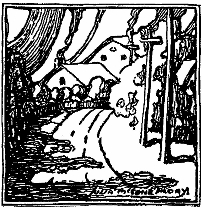
The Luck in the Head by M. John Harrison and Ian Miller, VG Graphics /
Gollancz, London, 1991, 14.99 (pounds).
I got this because I like Ian Miller's art, but the story is impressive too, a
touch of the truly alien, incomprehensible and yet frightening.
The True Christian Religion by Emanuel Swedenborg, Swedenborg Society,
London, 1975, 923pp, indices.
No price is indicated. I got it in a thrift store, beautifully bound in gold-stamped
blue cloth with a yellow, orange and gold d/w. This actually qualifies as
fantasy, as Swedenborg describes in detail his visions and travels in the
`spiritual world'. I find it unreadable alas, but bought it because the first
word on p.666 is `beast'...
Year In, Year Out by A. A. Milne, Dutton, New York, 1952, 215pp,
decorations by Ernest Shepard.
The first US edition but without d/w, another
thrift store find. It has the same appeal for me as books by John Moore and
Laurie Lee (also Loren Eiseley and August Derleth), well-written observations of
country life and customs.
When Acceptance Is Denial by Gil Eriksen, self-published,
Ft.Lauderdale (FL), 1993, 238pp, $12.95.
But I got it as a review copy. Didn't I promise to stop trying to review
psychobabble? Yes, but who could resist a book subtitled `A Handbook for People
Who Are Confused About Confusion'? A lot of diagrams and large print...
On p.166 the `true self' seems to be in the middle of a `black hole'... What twaddle!
The Brothers Robinson by Geoffrey Beare, Chris Beetles, London, 1992,
240pp, color and b&w art, wraps.
I don't find a price on this heavy pb that I got from Bud Plant. It's mostly
the art of Thomas Heath, Charles, and William Heath Robinson, with some 50
pages of commentary at the front. The art is beautifully printed on excellent
paper - I might snitch some of it for an IGOTS. Much of it must be in the
public domain, as Charles died in 1937 and William in 1944. Under the 50-year
rule, the work of Thomas, who died in 1953, would be copyright until 2003.
The Natural History of Stupidity by Paul Tabori, Barnes & Noble,
New York, 1993, 263pp, bibliography, index.
No price is given. This is stated to be a reprint of The Natural Science of
Stupidity, a book I searched for in vain after enjoying The Art of
Folly (1961) by the same author. Barnes & Noble apparently feels that
the material is timeless, as they do not bother to give a data for the original
publication - however it had to be before 1961, as the original book is mentioned
in the blurb on The Art of Folly.
Another fun book to browse in, at
any rate!

Witch Wood by John Buchan, Hodder & Stoughton, London, 1927,
380pp.
This is a book I have seen mentioned but had never read. I found this
rather decrepit copy of the first edition in a local thrift store. What with the
Scots dialect and the 17th-century theology, this is not nearly as easy a book
to read as Buchan's Salute to Adventurers that I read last year.
I would not be surprised if the speech of rural Scotsmen of the early 1600s (the Earl of Montrose, 1612-1650, is the principal historical figure) was incomprehensible to the modern ear - but how did Buchan know how they spoke, and why did he want to inflict his notion of their dialect on his readers? It seems to me that British readers of the 20s would have had almost as much trouble with this dialect as I do! The text and the speech of the hero and other educated characters is plain enough English (though Latin quotations and French songs also appear quite freely), but what is the reader to make of I whiles drink a stoup ower muckle, and I whiles gie a maur straik than I ettle when my bluid's het? Whatever sense comes through is because some of the words are given in English!
The plot turns on the various interpretations of the demented theology of John Calvin - the notions that our moral decisions are predestined and that the elect are saved no matter what their sins. The chief villain is a church elder who is also the leader of a coven of witches. Ephraim Caird is a rather unsatisfactory villain because the hero comes to believe that he is demented rather than evil - and in the end Caird does go totally mad. But this opinion of the villain must be Buchan's rather than anything a character at the time could have thought of!
Is this then a fantasy because some of the characters believe in witchcraft? Not in my opinion - it is still just a historical novel, because no supernatural events take place. The witches are singularly ineffective at anything other than inducing obsessive behavior in their own members - one half-mad old woman is tortured to death - and the witch-hunters totally incompetent. This aspect of the tale is probably quite true to history, and in fact Buchan claims in a prologue that the story is based on an assortment of old historical documents.
Unlike many historical novels, this one has a realistic (i.e. tragic) outcome. The hero does not get the girl (she dies of the plague), nor does he defeat the witches (he is excommunicated and goes abroad to be a soldier while the villains remain in control of the parish).
This is a book well worth reading if you can get used to the dialect - for all I know there may be modern editions that have smoothed out the worst of it. The question of individual conscience versus the moral authority of competing establishments is still with us, and in fact little closer to resolution now than it was then.
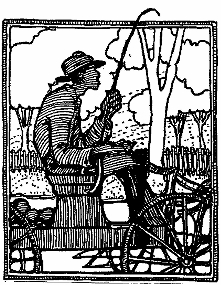
Rye Trisquits made by Nabisco - fear not, IGOTS is not about to turn into a gourmet magazine - are a sort of snack cracker that I have enjoyed for several years. Triscuits come in five flavors (plain, rye, bran, garden herb, and low-salt) and are available in most supermarkets. Except that the rye or `Deli-Rye' (as the blurbists call it) is no longer available here, even though it is still advertised on the boxes of the other flavors. After it vanished from local shelves, I was able to get it in Atlanta, but now it has vanished there as well. So I wrote Nabisco (they provide an address for that very purpose on the box), but all they would say is that the rye flavor is `no longer distributed in your area'. I asked them specifically, twice, where it is distributed, but they refuse to say! So if anyone thinks to look next time they visit their local food outlet, let me know. Perhaps if it isn't too far off I will go to that area and stock up. My sister kindly sent me some that she got on a trip to Boca Raton, Florida!
I have no idea what size a `Nabisco distribution area' may be. I suppose it must depend on the optimum size of the machine used to make and box the things. It seems unlikely to me that they would use a different machine for the different flavors, which are all of the same size and texture and packed in identical boxes.
Perhaps there is some problem with the rye and they don't want to admit it for fear of lawsuits - I have read that some of the `demon possession' cases of the Middle Ages, where entire towns appeared to go mad simultaneously, were caused by a psychedelic fungus called ergot which will grow on rye under the appropriate conditions of humidity and temperature. And the effect must have survived baking - I don't think medieval peasants ate raw rye! Certainly a lot of current events could be explained by ergotism; and if Nabisco had much concern for the health of their customers they would not be in business with the Reynolds tobacco operation.
John Haines asks rhetorically whether word processors `improve the words in your head', and goes on to say that elegant looking garbage is still garbage. I'm not sure whether he means to imply that IGOTS is elegant or garbage - but word processors were not meant to improve the words in your head. Their purpose is two-fold, to make correction of text easier and to make the printout easier to read. John says he will stick to his manual typewriter, which he can use by candle-light even when the power is off. But then, he could do the same with a battery-powered laptop computer, though he would probably have to wait for the power to be restored before he could print out what he had written, as there are few battery-powered printers other than dim thermal-paper gizmos.
Candide by Voltaire, Illustrated Editions, New York, nd, illustrated
by Mahlon Blaine.
This is one of those famous books that few people actually
read... I may never read it either, and I already have an edition with the
Mahlon Blaine art - but this copy that Ed Ripp in Chicago sold me has a color
Blaine original on the front fly! The art is dated 1965 - no one seems to know
when Blaine died (he was born in 1894), but rumors of his death were heard among
New York book dealers in 1970 according to Legman's book about him. His last
commissioned work was for the 1962 Canaveral Press editions of seven Edgar Rice
Burroughs fantasy titles.
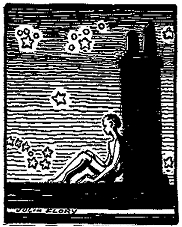
Houses and Travellers by W. S. Merwin, Atheneum, New York, 1977,
214pp, dust-jacket, $10.
According to the front d/w flap, only 1000 copies
of this were made, but after their usual defacements and abuses the local
Hampton public library threw it away.
These 78 very curious prose poems vary in length from a few lines to several pages. I cannot imagine that anyone would want to read them all at once, and yet the book is pleasant to browse in for a while -
"The story of the hinge is that it is learning to fly. `No hinge has ever flown,' the locks tell it again and again. `That is why we are learning,' it answers, `and then we shall teach the doors.'"
The Necronomicon edited by George Hay, Skoob bookS, London, 1992,
184pp, illus., wraps, 5.99 (pounds).
This is a second edition of a book about the famous grimoire that
originally appeared in 1978. The art is a mixture of medieval and modern
(uncredited) illustrations - the front fly is from the Owlswick Al Azif,
which is at least in the bibliography; and there is a reproduction of the title
page of the only English edition of 1571. Fascinating contributions by Sprague
de Camp and the late Angela Carter. The back cover promises a supplement called
The R'Lyeh Text for 1993, but I have not seen this offered.
Mary Gray says that the address of the local sf club, a PO box in Hampton from which the postal boffins returned IGOTS with the notation `no such number', still exists. She encloses a copy of Terry Gray's first issue of The Skiffy X-press which does, indeed, use that address, Box 9434, Hampton VA 23670.
Well, I will put it back on the mailing list and try again.
Steve Sneyd writes at length about IGOTS 11. He says the Bok (or Knight?) on p.4 reminded him of photos of Clark Ashton Smith sculptures in a British horrorzine - these were probably reprints from the little booklet of such photos published some time ago (I cannot find my copy). A local fan once told me that he had at one time owned one of these sculptures. George Haas gives a detailed description of how they were made in Chalker's In Memoriam: Clark Ashton Smith.
Steve also mentions the playwright Joe Orton who was sent to jail for inserting `obscene' collages into library books (which are now very valuable because of this defacement) - probably little worse than what the libraries themselves do to books before throwing them away...
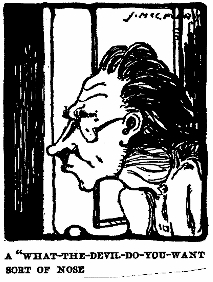
Steve incloses a sample of British TQM psychobabble - quite as nauseating as the US variety - and a page which he says comes from Poor Richard's Almanack. He asks if this is authentic - I cannot tell, as I don't have any edition of that annual. It appeared for 25 years (1732-1757) and is well-known to have been composed and printed by Benjamin Franklin under the pseudonym Richard Saunders. I have seen the title as a hardcover book, which must have consisted of a reprinting of all or part of the original publications. None of the local book outlets I have been in lately had a copy, but I later discovered that the entire text is in print at some elevated price.
The Orgone Biophysical Research Lab (Box 1395, El Cerrito CA 94530), whose logo looks like roadkill with arrow markings to drive around it, sends a single-sheet notice of their books on the bizarre sexual theories of Wilhelm Reich (he taught that sexual energy could be captured in an `orgone box' and used to control the weather) and warns that they may drop me from their mailing list if I don't order something - they have me in their files as Wyler Warnell Brooks. The big attraction on their future lists, it seems, is a `long-awaited' book by their Director of Research, James DeMeo (PhD) - Saharasia: The 4000 BCE Old-World Origins of Child-Abuse, Sex-Repression, and Social Violence.
It's A Conspiracy! by The National Insecurity Council, Earth Works
Press, Berkeley (1400 Shattuck Ave, #25, 94709) CA, 1992, 252pp, wraps, $9.95.
A Michael Litchfield holds the copyright to the text of this book even
though he isn't listed as the author. There is a page-long list of
acknowledgements. The conspiracies covered go back as far as the suspicious
death of Warren G. Harding and the tainted meat scandal of the Spanish-American
War, but mostly they are `modern' - the Nazis, Joe McCarthy, J Edgar Hoover,
Elvis, JFK, Vietnam, right on up through George Bush's Desert Storm and S&L
abominations. There is a 3pp bibliography, and an offer of membership in the
National Insecurity Council for a SASE. Very readable style. Did you know that
General Motors, Ford (Hitler awarded Henry Ford the Grand Cross of the German
Eagle), Standard Oil (leaded gas), and IT&T all helped build the Nazi war
machine before WWII?
Rosemary Pardoe notes that The Everlasting Club, a bimonthly apa devoted to the discussion of ghost stories, has only one American member. If you are interested, the dues are 6.90 sterling or $11 (surface mail) or $34 (airmail) to her at Flat One, 36 Hamilton Street, Hoole, Chester CH2 3JQ.
Rosemary also encloses the current publication list for her Haunted Library - stories in the M. R. James tradition and also some psychic investigators, including Ernie Pine, an Aussie biker, who finds a bunyip in a launderette. I am fairly well up on most supernatural creatures, but somehow I never was able to grasp the concept of the bunyip well enough to remember what they are supposed to look like or do to you!
Margaret Cubberly (she and I were founding members of the local sf club, HaRoSFA) sends a May '93 newspaper photo of the infamous Ollie North on a bench in Smithfield (just across the James River from here) with Benjamin Franklin - the photo is taken in such a way that North appears to have little black wings. I didn't know about this life-size sculpture of Franklin, a wonder it hasn't been vandalized more seriously than being used to publicize a crooked politician. Margaret attached to this the letter she wrote the editor after seeing it, and notes that she got a threatening phone call after the letter appeared - she called Ollie a turkey!
Margaret also says she just got around to reading the Avram Davidson Adventures in Unhistory mentioned here recently and enjoyed it. She says she got it direct from the publisher, George Scithers, after reading a review in the NYTimes - and that he sounded `rather surly'! Well, maybe she called at a bad time - I have met George at cons and wouldn't say he was any worse than morose and taciturn...
Margaret collects Angela Carter books, and I told her about the Necronomicon mentioned above.
The Alchymist's Journal by Evan S. Connell, North Point Press, San
Francisco, 1991, 213pp, wood engravings by Michael McCurdy, $19.95.
I looked
forward to this, as I consider Connell (A Long Desire, The White Lantern, Son
of the Morning Star, Points for a Compass Rose) one of the great living
writers. It is a beautifully made book, set in Mergenthaler Cloister -
appropriately exotic and yet easy to read. But while I can enjoy a paragraph at
a time, this odd meditation on the medieval alchemists defeats me as a book to
actually read - there are not only no characters, no plot, no action, but
no sense of what Connell, as a modern man, thought about the whole business.
In fact, I was so anxious to be sure of getting this book that I must have ordered it twice, and have an extra copy.
ConAdian is more of a con-game than a convention as far as I'm concerned - I have been writing them since last year about how an amateur US dealer like myself could get anything through Canadian Customs and into their Dealer's Room. Not a word have I heard back. Now in their Spring 1994 Progress Report #5 - which I recieved around March 1 - they allow as how they have turned this function over to a Kim Takeuchi, who `will now be answering letters and dealing with Customs directly'. And on the same page they have the unmitigated gall to say that the `deadline for returning all forms in the package, as well as moneys owed' is March 15! In other words, they want me to buy a very expensive blind pig in a poke - fat chance, eh.
Pastures In The Sky by Patrick Woodroffe, Pomegranate, San Francisco,
1993, 111pp, full color, $30.
At least I think that was the price, it isn't on the book. The mailing address is Box
6099, Rohnert Park CA 94927. The book was printed in Korea, and a beautiful job too. This
is a retrospective and contains art from several of his previous books and some from
various private collections. If you have seen Mythopoeikon or Hallelujah
Anyway you know what Woodroffe's obsessively detailed fantasies look like. But I had
never seen The Adventures of Tinker, the Hole-Eating Duck, or Alice's
encounter with the Bandersnatch, or the wonderful art for what is described as a
screenplay called Your Place or Mine.
Victorian Women / A Book of Days, compiled by Sally Fox, Little Brown,
Boston, 1987, period art.
This is one of those fancy appointment books for 1988, and scribbled in too. But it
wasn't expensive in a thrift store - and it has good color reproductions of a c.1900
`before and after' advertising pamphlet for the Electric Blickensderfer typewriter.
Marvelous Monikers by Tad Tuleja, Harmony Books, New York, 1990,
206pp, index, bibliography, wraps, $9.95
This is a reference on the origin of names of things that were named after someone.
It isn't all that great - Tad doesn't seem to know whether Sax Rohmer's real name was Wade
or Ward - but then I got it free from some outfit that occasionally sends me consumer
questionnaires to fill out. I suppose they feel it provides balance to have a
reluctant consumer in the sample!
The Mushroom Jungle by Steve Holland, Zeon, England, 1993, 200pp,
b&w and color illus., index, bibliography, wraps, 14.95 (sterling).
This is an illustrated history of the British schlock pb publishers of the 1950s. Not
all sf, of course, but the sf is the most bizarre - judging from the covers,
Mammalia by John Lane or Chloroplasm by Dee Carter might be even
worse than Queen Kong or Werewolf vs The Vampire Woman!
Journey Into Oneness by Michael J. Roads, Kramer, Tiburon CA, 1994,
231pp, wraps, $10.95.
An unsolicited review copy - the unwary should note
that tiburon is Spanish for shark... Psychobabble in the form of a
pseudofantasy - there are Blue Beings, and even a Wonder-Neap. Blech...
Vladimir Saliy in the Ukraine was getting IGOTS by `Poste Restante' (similar to our old `General Delivery', meaning the addressee would pick it up at the Post Office) at the General PO in Kiev - but #10 (mailed in October of 1993) just wandered back with strange scribbles on the envelope. I thought at first they were Russian (or Ukrainian, which would be equally opaque to me) but now I see that one scribble is consistent with the French post restante - it says non reclame', that is, unclaimed. Is French de rigueur for Ukrainian postal clerks?
The Mystic Mandrake by C. J. S. Thompson, University Books, New York,
1968, 253pp, index, illus., d/w, $5.
I suppose any fantasy fan has heard mention of the mandrake, a plant of magical power
whose root supposedly resembles a man. Not only was it believed to scream when plucked out
of the ground, but the sound was said to be maddening or even fatal. Here is all anyone
could want to know about the legend and the actual plants, by the curator of the
museum of the Royal College of Surgeons. The more PC reader will be glad to hear
that there are also womandrakes whose roots resemble a female figure.
In shelving this I find it is a duplicate - if anyone wants the extra let me know, we could probably agree on a reasonable price.
Prologue by Charles S. Brooks, Harcourt Brace, New York, 1931, 335pp,
illus. by Julia McCune Flory.
A discard from the Fairfax County public library, and they went to a great deal of
trouble with a heavy marker to conceal their previous ownership. A local color memoir
whose author (1878-1934 and no relation that I know of) mentions other books but modestly
fails to mention their titles. I have had this book a long time, and only mention it here
because I decided to use the art in this issue. The locale may be Akron Ohio (the
Cuyahoga River is mentioned), or perhaps the author meant to leave it undefined
- he invents a narrator named Henry Marston as well.
Alpha-Centauri by Robert Siegel, Cornerstone Books, Westchester (IL),
1980, 256pp, illus. and d/w by Kurt Mitchell, $9.95.
A very attractive book found undefaced in a local thrift store. The art looks like
fantasy while the title sounds more like sf, and in fact the author (said in the blurb to
be `one of America's notable younger poets') has dragged in time travel and travel to
Alpha Centauri as well as talking animals and centaurs. Probably intended for
the `young adult' market as the protagonist is a teenage girl with a horse, but
I enjoyed it.
This Ever Diverse Pair by Owen Barfield, Floris, Edinburgh, 1985,
144pp, wraps, 6.95 (sterling).
Diane Fox down in Oz sent me this odd short fantasy by one of the lesser-known members
of the Tolkien-Lewis-Williams circle. The original publication was 1950, and there is an
introduction by Walter de la Mare and a review-blurb by C. S. Lewis, who calls it a
philosophic comedy. It seems to be about the daily affairs of a solicitor's office in
England (or Scotland?), but nothing is as it seems... The little I have read of it has
something of the flavor of Mervyn Peake's Mr Pye or one of the fantasies
by D. B. Wyndham-Lewis.
Rynosseros by Terry Dowling, Aphelion, North Adelaide (South
Australia), 1990, 228pp, wraps, $12.95 (Aus.).
A collection of stories set
in an unlikely but amazing future Australia - rather like Cordwainer Smith's
Instrumentality of Man series in its bizarre characters and imagery and
poetic language. Also sent by Diane Fox. I had heard of the title, but this is
the first copy I had seen.
The National Directory of Haunted Places by Dennis William Hauck,
Athanor Press, Sacramento, 1994, 406pp, illus., wraps, $24.95.
Or so it says on the flyer - the book is announced for June. I think I have requested
the review copy they offer, we will see. All sites are said to be authenticated,
with information provided as to how to visit them. Sounds like a useful guide, I
have always wanted to see a ghost - if there is any such thing.
The Knave of Hearts by Maxfield Parrish, Ten Speed Press (Box 1723),
Berkeley (CA), 1993, 2pp, d/w, $12.95.
Actually, this is only the 1925 Parrish art for The Knave of Hearts, a 1921 play
by Louise Saunders based on the old nursery rhyme about the theft of some `tarts' (no, not
that kind of tarts - these were a sort of fruit pie). But the color art is beautifully
printed in Korea on both sides of a long piece of heavy coated paper and
accordion-folded into an illustrated hard binding with a vellum wrapper. The
1925 book is extremely rare and expensive now - though I got both the hardcover
and the spiral-bound editions cheaply enough back in the 60s.
Criminals of America by Phil Farley, author's edition, New York, 1876,
638pp, indices, illustrated.
Farley was a Detective Officer for 25 years, but he does not say with what police force.
His introduction is amazingly liberal for the time: `Lift the poor thief when you meet
him. Do not kick him further down', and so on. The two indices list the page number of the
full-page pen portrait and the text referring to each criminal, about 200 altogether. I
got this in a local thrift store - it would probably be of some value if the
first 18 pages weren't missing, apparently a binding error.
Even so, the book might be of interest to anti-genealogists, for looking up the people you don't want to find in your family tree... I see there is a John McCune, a thief and gambler, perhaps related to our interior artist; and there is a William Brooks, said to have been a `hotel thief' - he was about my size, a little shorter (5'8" and 150 lbs at age 40), but looks nothing like any of the men from the Brooks family that I have seen.
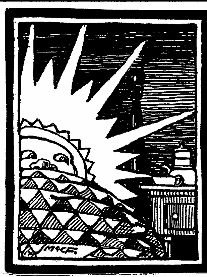
A Virginian in Yankeeland by Benjamin Evans Dean, B. E. Dean Co.,
Owego (NY), 1989, 659pp, illus. photos, wraps.
And that was only Volume One... No price is mentioned, but the thing was published
simultaneously in Canada by the same firm. Dean claims to be the fifth-generation
descendant of George Washington through his `secret' (I suppose he means illegitimate)
son Israel Dean. The actual text is about anything and nothing much, at exhaustive
length. The author admits that he would never have written the book except for
the availability of word-processor technology. Nice computerized typesetting -
he even has ligatures - but apparently lacked a spell-checker as he has
`portens' for portents.
Collected Plays (V.II) by Oscar Mandel, Unicorn Press, Santa Barbara
(CA), 1972, 204pp, chronology, $7.50.
This copy was `withdrawn' from the Hampton public library - is there any technical
difference between library books stamped `withdrawn' and those stamped `discarded'? I
bought it because of the names of the plays - The Monk Who Wouldn't, The Fatal French
Dentist, Professor Snaffle's Polypon, The Sensible Man of Jerusalem, Adam Adamson,
and Of Angels and Eskimos - sounded a little like something by Edward
Gorey. I generally find plays hard to read, but these are pretty good. Adam
Adamson is a moral fantasy about how heroic the average man can be expected
to act when confronted with something like the Nazis; and Angels and
Eskimos is a comedy about a society where there is no jealousy or greed or
racism - men happily loan their wives out for romantic adventures and worry
whether their daughters are good enough for a Negro/Eskimo/Jew baritone
mechanic; used-car dealers try to dicker their prices down; and thieves sneak
into houses to leave stuff.
We also heard from:
Camille Cazadessus, who wanted the flyer on Rick Norwood's Prince
Valiant book - alas, I could not find it.
Chester Cuthbert, who considers himself a failure because he only read 88 of a
planned 130 books last year - I haven't been keeping count, but I'm sure he's way ahead
of me! Chester also sends some clippings on the Canadian Customs idiocies.
Al Fitzpatrick, another energetic reader (but he and Chester don't do zines)
who sends a depressingly long list of books he's read.
Paddy Fletcher, who sent the British Weekly Telegraph for January 26, 1994
- claims to be the `best of' The Daily Telegraph and The Sunday
Telegraph. Interesting to see how the news is treated over there.
John Howard, who understands my difficulty in commenting on poetry
and quotes Archibald MacLeish - A poem should not mean / but be.
Terry Jeeves, who thinks the p.4 illo in #11 is by Bok.
Regina Krummel, who sent a pome.
Dan Knight at United Mythologies sends the third issue of The Boomer Flats
Gazette, his zine devoted to R. A. Lafferty.
Ernest Mann at the Little Free Press who sends his 99th issue with a wonderful
account of how he built a raft and launched it in Minneapolis with the intent of sailing
to New Orleans.
David Monette, who sends a nice piece of his own fantasy art made into a postcard
- but with no mention of whether it is a contribution, an offer of his services, a random
act of senseless beauty, or what...
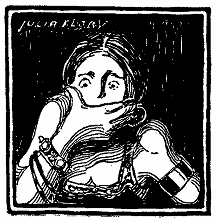
Harry Morris, who wishes he had ordered the Mortensen Monsters &
Madonnas when I reviewed it in IGOTS 6 - says he will try the old address.
Let us know if there's any answer, it's a great book!
Frances Needham, who notes a COA and asks if I turned out like my father said I
would - well, my father said different things at different times, but none of
them were very close to my current situation.
Ken Ozanne writes that he might be over this way from Oz later in the year, and
says that the nitrogen tri-iodide mentioned lastish will eventually explode if you
look at it wrong... Says he and son Alex will be playing world championship bridge in
Albuquerque in late September. Also agrees with Steve Sneyd that Space
Train is the worst sf novel of all time - well, so far...
Henry Welch of Knarley Knews fame says that at that price the
automatic tent I mentioned in IGOTS 11 probably won't last long - could be, I
only mentioned it as a novelty, I know nothing at all about camping equipment.
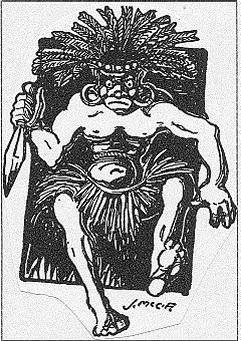
Typing completed March 20, 1994 - I would call it an April Fool issue but it is probably no more foolish than the others!
